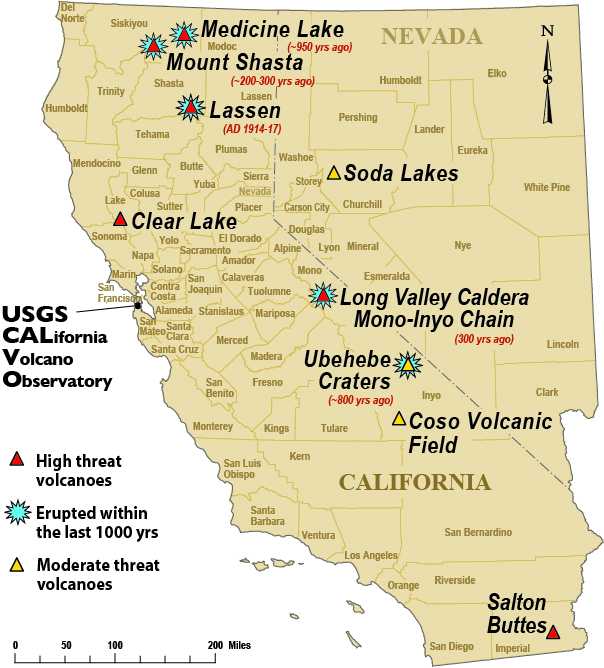USGS Volcano Hazard Program and the California Volcano Observatory (CalVO)
The U.S. Geological Survey (USGS), Volcano Hazards Program monitors volcanoes, assesses their hazards, responds to volcanic crises, and conducts research to fulfill a Congressional mandate that the USGS issue "timely warnings" of potential volcanic hazards to responsible emergency-management authorities and to the populace affected (Public Law 93-288). The USGS provides eruption warnings and related notifications based on data and observations collected from extensive monitoring networks operated by five USGS volcano observatories.
The USGS California Volcano Observatory (USGS CalVO), with staff and data center in Menlo Park, CA, has responsibility for monitoring all volcanoes in the states of California and Nevada. During periods of quiescence, CalVO watches for signs of unrest, conducts research related to volcanic hazards, and provides long-term hazard assessments to government agencies, private industry, non-governmental organizations, educational institutions, and the public. As a volcano moves from quiescent to active, CalVO will issue hazard alerts, providing timely information as volcanic activity ramps up, and, as importantly, as the volcano returns to quiescence. This information is communicated through telephone call-down procedures and written notices.
The national report on volcanic threat published by the USGS in 2005 (USGS Open-File Report 2055-1164 and a 2011 agency update) ranks the youngest and potentially dangerous centers in California and Nevada as:
High to Very High Threat Potential-
Clear Lake Volcanic Field(Lake County)
-
Lassen Volcanic Center(Shasta County)
-
Long Valley Caldera(Mono County)
-
Medicine Lake(Siskiyou & Modoc Counties)
-
Mono-Inyo Chain(Mono County)
-
Mount Shasta(Siskiyou County)
-
Salton Buttes(Imperial County)
-
Coso Volcanic Field(Inyo County)
-
Soda Lakes(Nevada, Churchill County)
-
Ubehebe Craters(Inyo County)
-
Brushy Butte(Shasta County)
-
Eagle Lake Volcanic Field(Lassen County)
-
Golden Trout Creek Volcanic Field(Tulare County)
-
Lavic Lake Volcanic Field(San Bernardino County)
-
Silver Lake Volcanic Field(Shasta County)
-
Tumble Buttes(Shasta County)
-
Twin Buttes(Shasta County)
For more information, please contact the Scientist in Charge, Margaret Mangan.
